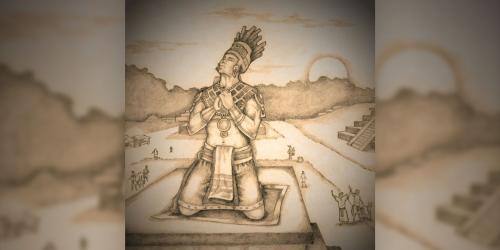You are here
Book of Mormon Central is in the process of migrating to our new Scripture Central website.
We ask for your patience during this transition. Over the coming weeks, all pages of bookofmormoncentral.org will be redirected to their corresponding page on scripturecentral.org, resulting in minimal disruption.
Come Follow Me 2020: Helaman 7-12

Scripture Block
Helaman 7-12
August 24–30. “Remember the Lord”
KnoWhys
Recommended Resources
Learn about the Book of Mormon with verse by verse commentaries from renowned Book of Mormon scholars like John W. Welch and Brant A. Gardner in the ScripturePlus app. Read this week's KnoWhy connected with the Come Follow Me curriculum, and watch a video elucidating an insight in this week's scripture reading.
Reading Plan
Structure your personal scripture study by following a multimedia, day by day plan. Each day's assignment includes the required scripture passages from the Come Follow Me curriculum, as well as suggestions for additional resources to bring context and understanding to your study.
Monday
- Scripture: Helaman 7:1-29
-
Quote: “The invitation to repent is rarely a voice of chastisement but rather a loving appeal to turn around and to ‘re-turn’ toward God. It is the beckoning of a loving Father and His Only Begotten Son to be more than we are, to reach up to a higher way of life, to change, and to feel the happiness of keeping the commandments. Being disciples of Christ, we rejoice in the blessing of repenting and the joy of being forgiven. They become part of us, shaping the way we think and feel.”
Anderson, Neil L. “’Repent…That I May Heal You’”, General Conference October 2009. - Video: Why Did Nephi Prophesy Near “the Highway Which Led to the Chief Market?”
Explore Further
Tuesday
- Scripture: Helaman 8:1-28
-
Quote: “Here is one of the best passages in all of scripture on proving Christ…. Nephi, along with all other prophets, rejoiced in the coming of Christ and delighted to show the evidence of his imminent mission and ministry…. Nephi gave us the most detailed list of those who testified of the coming of the Son of God; Moses, Abraham, Zenos, Zenock, Ezias, Isaiah, Jeremiah, Lehi and Nephi, ‘and almost all of our fathers have testified of the coming of Christ,’ We have, indeed, received ‘so many witnesses.’”
Ogden, D. Kelly, and Andrew C. Skinner. Verse by Verse: the Book of Mormon. Salt Lake City, UT: Deseret Book, 2011. 2:92. -
Quote: “Other great prophets of the Book of Mormon—in their own way and time—testified of the divinity of the Lord Jesus Christ. Among them were the brother of Jared, Zenock, Neum, and Zenos. Testimonies of Jesus Christ that predated His birth in Bethlehem were also recorded from King Benjamin, Abinadi, Alma the Elder, Alma the Younger, Amulek, the sons of Mosiah, Captain Moroni, the brothers Nephi and Lehi, and Samuel the Lamanite. In a seemingly endless sequence of prophetic proclamations—testimonies of ‘all the holy prophets’ for ‘a great many thousand years before his coming’ —the Book of Mormon makes the solemn declaration that Jesus is the Christ, our Savior and Redeemer.”
Nelson, Russell M. “A Testimony of the Book of Mormon,” General Conference October 1999 - Scripture: Helaman 8:10-28
Explore Further
Wednesday
- Scripture: Helaman 9:1-41
- KnoWhy 180: Why Could Seantum be Convicted Without Any Witnesses?
Thursday
- Scripture: Helaman 10:1-19
- KnoWhy 181: Why is There Temple Imagery in Helaman 10?
-
Quote: “Nephi demonstrated his absolute and uncompromising loyalty to the Savior of whom he prophesied. His life modeled the pattern of behavior of those who have their callings and election made sure, as revealed by Joseph Smith: ‘When the Lord has thoroughly proved him, and finds that the man is determined to serve Him at all hazards, then the man will find his calling and his election made sure.’ Nephi did have his calling and election made sure.”
Ogden, D. Kelly, and Andrew C. Skinner. Verse by Verse: the Book of Mormon. Salt Lake City, UT: Deseret Book, 2011. 2:96 -
Quote: “While the Lord truly taught those to whom He had given the priesthood that by faith mountains would move—and there are recorded instances of such—my hope is to bring greater understanding to that aspect of the doctrine of the priesthood which moves individuals closer to God, affording them the opportunity to become like Him and live eternally in His presence. This doctrine involves both the sons and the daughters of God.”
Cardon, Craig A. “Moving Closer to Him,” General Conference October 2006.
Friday
- Scripture: Helaman 11:1-19
- KnoWhy 182: How Did Nephi Use the Power to Seal on Earth and in Heaven?
Saturday
- Scripture: Helaman 11:20-38
- KnoWhy 423: Is the Book of Mormon's Depiction of Guerrilla Warfare Realistic?
Sunday
- Scripture: Helaman 12:1-26
- KnoWhy 183: Why Did Mormon Say the Children of Men are Less than the Dust of the Earth?
Additional Resources (Bibliography)
Helaman 7
Helaman 7:4
Welch, John W., and Greg Welch. “The Nephite Judges.” In Charting the Book of Mormon: Visual Aids for Personal Study and Teaching. Provo, UT: Foundation for Ancient Research and Mormon Studies, 1999, chart 33.
Welch, John W., and Greg Welch. “Who Kept the Records in the Book of Mormon? (By Lineages).” In Charting the Book of Mormon: Visual Aids for Personal Study and Teaching. Provo, UT: Foundation for Ancient Research and Mormon Studies, 1999, chart 17.
Helaman 7:10–11
Book of Mormon Central. “Why Did Nephi Prophesy Near “the Highway Which Led to the Chief Market?” (Helaman 7:10).” KnoWhy 178 (September 1, 2016).
Sorenson, John L. “Nephi's Garden and Chief Market.” In Reexploring the Book of Mormon, edited by John W. Welch, 236–238. Provo, UT/Salt Lake City: FARMS/Deseret Book, 1992.
Sorenson, John L. “Towers in the Book of Mormon.” Insights: A Window into the Ancient World 21, no. 2 (2001): 3.
Hunt, Jr, Wallace E. “Notes and Communications: The Marketplace.” Journal of Book of Mormon Studies 4, no. 2 (1995): 138–141.
Helaman 7:15
Welch, John W. “Was Helaman 7–8 An Allegorical Funeral Sermon?” In Reexploring the Book of Mormon, edited by John W. Welch, 239–241. Provo, UT/Salt Lake City: FARMS/Deseret Book, 1992.
Helaman 7:21
Welch, John W., and Greg Welch. “A Comparison of Nephite Law Lists.” In Charting the Book of Mormon: Visual Aids for Personal Study and Teaching. Provo, UT: Foundation for Ancient Research and Mormon Studies, 1999, chart 127.
Helaman 7:23–24
Bowen, Matthew L. “’They Were Moved with Compassion’ (Alma 27:4; 53:13): Toponymic Wordplay on Zarahemla and Jershon.” Interpreter: A Journal of Mormon Scripture 18 (2016): 233–253.
Welch, John W., and Greg Welch. “Nephite Cycle of Righteousness: Mormon's Warning for Us Today.” In Charting the Book of Mormon: Visual Aids for Personal Study and Teaching. Provo, UT: Foundation for Ancient Research and Mormon Studies, 1999, chart 144.
Helaman 8
Welch, John W. “Was Helaman 7–8 An Allegorical Funeral Sermon?” In Reexploring the Book of Mormon, edited by John W. Welch, 239–241. Provo, UT/Salt Lake City: FARMS/Deseret Book, 1992.
Helaman 8:7
Bowen, Matthew L. “’He Is a Good Man’: The Fulfillment of Helaman 5:6-7 in Helaman 8:7 and 11:18-19.” Interpreter: A Journal of Mormon Scripture 17 (2016): 165–170.
Helaman 8:13–20
Meservy, Keith H. “Ezias.” In Encyclopedia of Mormonism, Edited by Daniel H. Ludlow. Vol. 2. New York: Macmillan, 1992.
Helaman 8:14
Hunt, Jr, Wallace E. “Moses’ Brazen Serpent as It Relates to Serpent Worship in Mesoamerica.” Journal of Book of Mormon Studies 2, no. 2 (1993): 121–131.
Skinner, Andrew C. “Serpent Symbols and Salvation in the Ancient Near East and the Book of Mormon.” Journal of Book of Mormon Studies 10, no. 2 (2001): 42–55, 70–71.
Skinner, Andrew C. “Savior, Satan, and Serpent: The Duality of a Symbol in the Scriptures.” In The Disciple as Scholar: Essays on Scripture and the Ancient World in Honor of Richard Lloyd Anderson, edited by Stephen D. Ricks, Donald W. Parry and Andrew H. Hedges, 359–384. Provo, UT: Foundation for Ancient Research and Mormon Studies, 2000.
Wirth, Diane E. “Quetzalcoatl, the Maya Maize God, and Jesus Christ.” Journal of Book of Mormon Studies 11, no. 1 (2002): 4–15, 107.
Helaman 8:17–18
Bowen, Matthew L.. “’In the Mount of the Lord It Shall Be Seen’ and ‘Provided’: Theophany and Sacrifice as the Etiological Foundation of the Temple in Israelite and Latter-day Saint Tradition.” Interpreter: A Journal of Mormon Scripture 5 (2013): 201–228.
Helaman 8:19–20
Ludlow, Daniel H. “Zenos.” In Encyclopedia of Mormonism, Edited by Daniel H. Ludlow. Vol. 4. New York: Macmillan, 1992.
Tvedtnes, John A. “Jeremiah's Prophecies of Jesus Christ.” In The Most Correct Book: Insights from a Book of Mormon Scholar, 99–103. Salt Lake City: Cornerstone Publishing, 1999.
Welch, John W., and Greg Welch. “Contents of the Plates of Brass.” In Charting the Book of Mormon: Visual Aids for Personal Study and Teaching. Provo, UT: Foundation for Ancient Research and Mormon Studies, 1999, chart 14.
Helaman 8:21
Bowen, Matthew L. “’They Were Moved with Compassion’ (Alma 27:4; 53:13): Toponymic Wordplay on Zarahemla and Jershon.” Interpreter: A Journal of Mormon Scripture 18 (2016): 233–253.
Helaman 8:22
Book of Mormon Central. “Why Did Nephi Rely on Earlier Testimonies of Christ? (Helaman 8:22).” KnoWhy 179 (September 2, 2016).
Helaman 9
Call, Michael J. “Reading Competency in the Book of Mormon: Abish and Other Model Readers.” BYU Studies Quarterly 56, no. 2 (2017): 59–70.
Ludlow, Victor L. “Secret Covenant Teachings of Men and the Devil in Helaman Through 3 Nephi 8.” In The Book of Mormon: Helaman Through 3 Nephi 8, According to Thy Word, edited by Monte S. Nyman and Charles D. Tate, Jr., 265–282. Provo, UT: Religious Studies Center, Brigham Young University, 1992.
Welch, John W., and Greg Welch. “Legal Cases and Procedures in the Book of Mormon.” In Charting the Book of Mormon: Visual Aids for Personal Study and Teaching. Provo, UT: Foundation for Ancient Research and Mormon Studies, 1999, chart 121.
Helaman 9:35–36
Book of Mormon Central. “Why Could Seantum be Convicted Without Any Witnesses? (Helaman 9:35–36).” KnoWhy 180 (September 5, 2016).
Helaman 9:38
Welch, John W. “The Case of an Unobserved Murder.” In Reexploring the Book of Mormon, edited by John W. Welch, 242–244. Provo, UT/Salt Lake City: FARMS/Deseret Book, 1992.
Helaman 10
Skinner, Andrew C. “Nephi's Ultimate Encounter With Deity: Some Thoughts on Helaman 10.” In The Book of Mormon: Helaman Through 3 Nephi 8, According to Thy Word, edited by Monte S. Nyman and Charles D. Tate, Jr., 115-127. Provo, UT: Religious Studies Center, Brigham Young University, 1992.
Smoot, Stephen O. “The Divine Council in the Hebrew Bible and the Book of Mormon.” Interpreter: A Journal of Mormon Scripture 27 (2017): 155–180.
Welch, John W., and Greg Welch. “Nephite Cycle of Righteousness: Mormon's Warning for Us Today.” In Charting the Book of Mormon: Visual Aids for Personal Study and Teaching. Provo, UT: Foundation for Ancient Research and Mormon Studies, 1999, chart 144.
Helaman 10:4–5
Wilkins, Alan L. “Nephi states that God gives liberally to those who ‘ask not amiss.’ What guidelines can help us pray in accordance with God’s will?” Ensign 29, no. 2 (1999).
Helaman 10:8
Book of Mormon Central. “Why is There Temple Imagery in Helaman 10? (Helaman 10:8).” KnoWhy 181 (September 6, 2016).
Helaman 7:10
Book of Mormon Central. “Why Do New Testament Words and Phrases Show Up in the Book of Mormon? Part 4: Revelations to Nephite Prophets as the Source (Part B) (Helaman 7:10).” KnoWhy 531 (September 12, 2019).
Helaman 10:16–17
Reynolds, Noel B. “The Language of the Spirit in the Book of Mormon.” Interpreter: A Journal of Latter-day Saint Faith and Scholarship 33 (2019): 187–222.
Helaman 11
Hawker, Jim. “Let There Be a Famine in the Land.” Interpreter: A Journal of Mormon Scripture 30 (2018): 305–330.
Ludlow, Victor L. “Secret Covenant Teachings of Men and the Devil in Helaman Through 3 Nephi 8.” In The Book of Mormon: Helaman Through 3 Nephi 8, According to Thy Word, edited by Monte S. Nyman and Charles D. Tate, Jr., 265–282. Provo, UT: Religious Studies Center, Brigham Young University, 1992.
Helaman 11:3
Welch, John W., and Greg Welch. “Nephite Cycle of Righteousness: Mormon's Warning for Us Today.” In Charting the Book of Mormon: Visual Aids for Personal Study and Teaching. Provo, UT: Foundation for Ancient Research and Mormon Studies, 1999, chart 144.
Helaman 11:4
Book of Mormon Central. “How Did Nephi Use the Power to Seal on Earth and in Heaven? (Helaman 11:4).” KnoWhy 182 (September 7, 2016).
Helaman 11:8–9
Bowen, Matthew L. “’He Is a Good Man’: The Fulfillment of Helaman 5:6-7 in Helaman 8:7 and 11:18-19.” Interpreter: A Journal of Mormon Scripture 17 (2016): 165–170.
Helaman 11:17–19
Bowen, Matthew L. “’He Is a Good Man’: The Fulfillment of Helaman 5:6-7 in Helaman 8:7 and 11:18-19.” Interpreter: A Journal of Mormon Scripture 17 (2016): 165–170.
Welch, John W., and Greg Welch. “Nephite Cycle of Righteousness: Mormon's Warning for Us Today.” In Charting the Book of Mormon: Visual Aids for Personal Study and Teaching. Provo, UT: Foundation for Ancient Research and Mormon Studies, 1999, chart 144.
Helaman 11:25
Book of Mormon Central. “Is the Book of Mormon's Depiction of Guerrilla Warfare Realistic? (Helaman 11:25).” KnoWhy 423 (April 10, 2018).
Helaman 12
Mackay, Thomas W. “Mormon's Philosophy of History: Helaman 12 in the Perspective of Mormon's Editing Procedure.” In The Book of Mormon: Helaman Through 3 Nephi 8, According to Thy Word, edited by Monte S. Nyman and Charles D. Tate, Jr., 129–146. Provo, UT: Religious Studies Center, Brigham Young University, 1992.
Welch, John W., and Greg Welch. “Writings of Mormon.” In Charting the Book of Mormon: Visual Aids for Personal Study and Teaching. Provo, UT: Foundation for Ancient Research and Mormon Studies, 1999, chart 20.
Helaman 12:3
Hardy, Grant R. “Mormon's Agenda.” In Reexploring the Book of Mormon, edited by John W. Welch, 245–247. Provo, UT/Salt Lake City: FARMS/Deseret Book, 1992.
Helaman 12:7
Book of Mormon Central. “Why Did Mormon Say the Children of Men are Less than the Dust of the Earth? (Helaman 12:7).” KnoWhy 183 (September 8, 2016).
Helaman 12:13 (1830 edition)
Skousen, Royal. “Hebraic Conditionals in the Book of Mormon.” In Pressing Forward with the Book of Mormon: The FARMS Updates of the 1990s, edited by John W. Welch and Melvin J. Thorne, 201–203. Provo, UT: FARMS, 1999.
Helaman 12:23
Book of Mormon Central. “What Can We All Learn about Repentance from the Tragic Loss of the 116 Book of Mormon Pages? (Helaman 12:23).” KnoWhy 504 (March 1, 2019).




